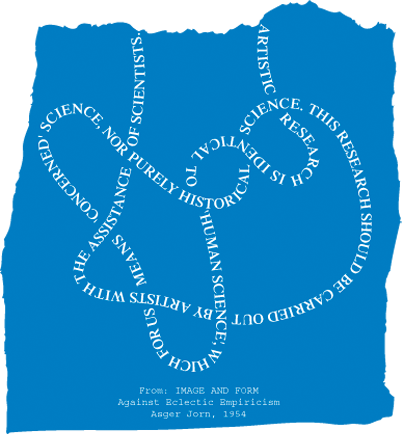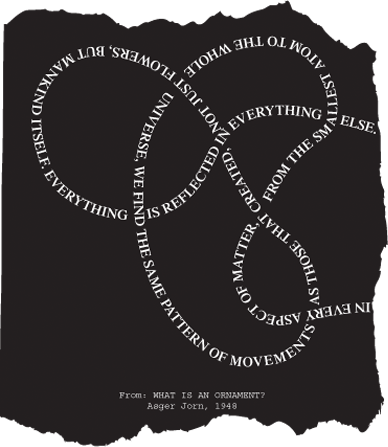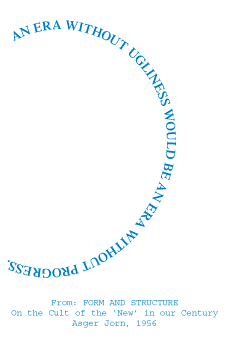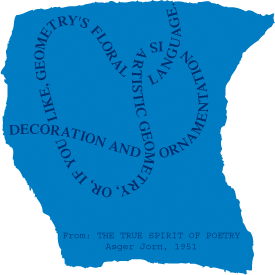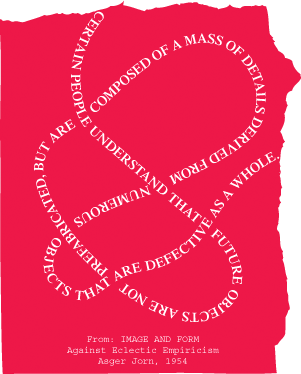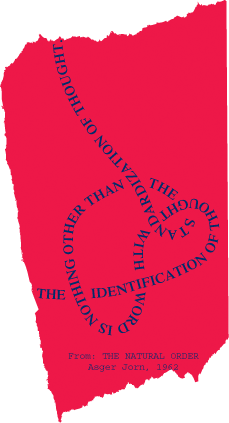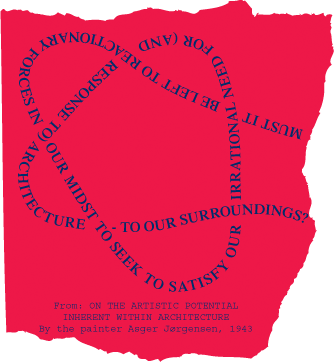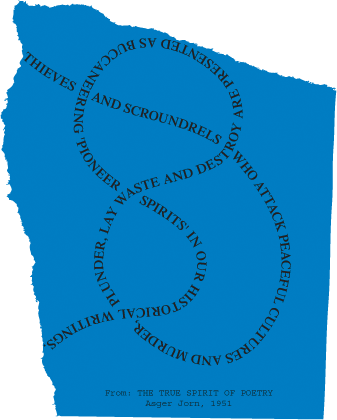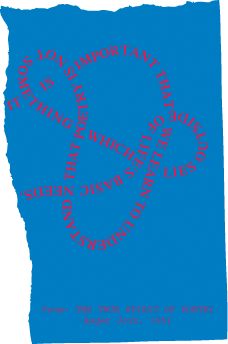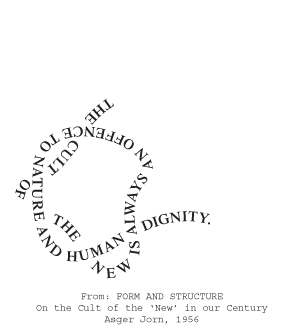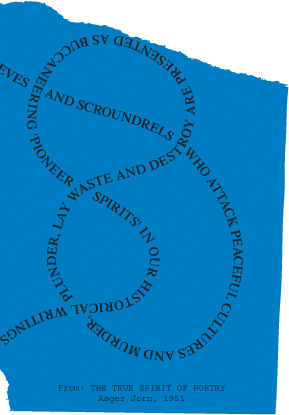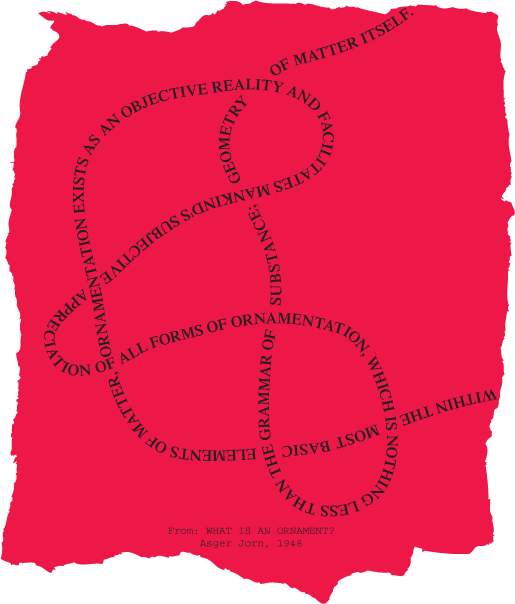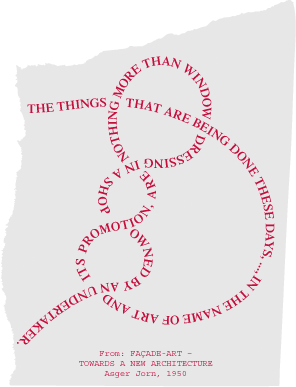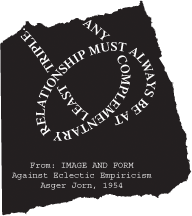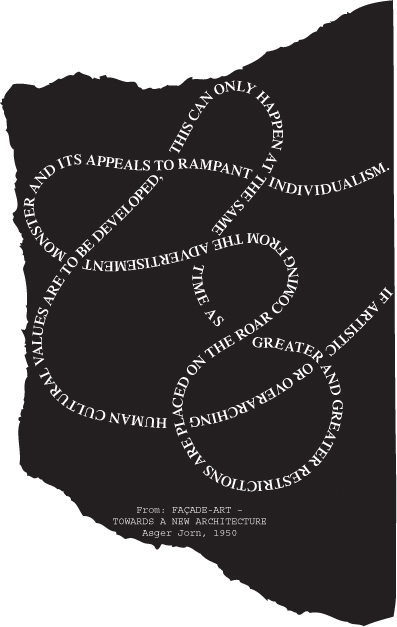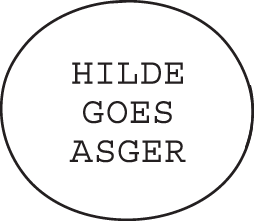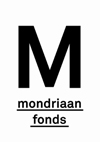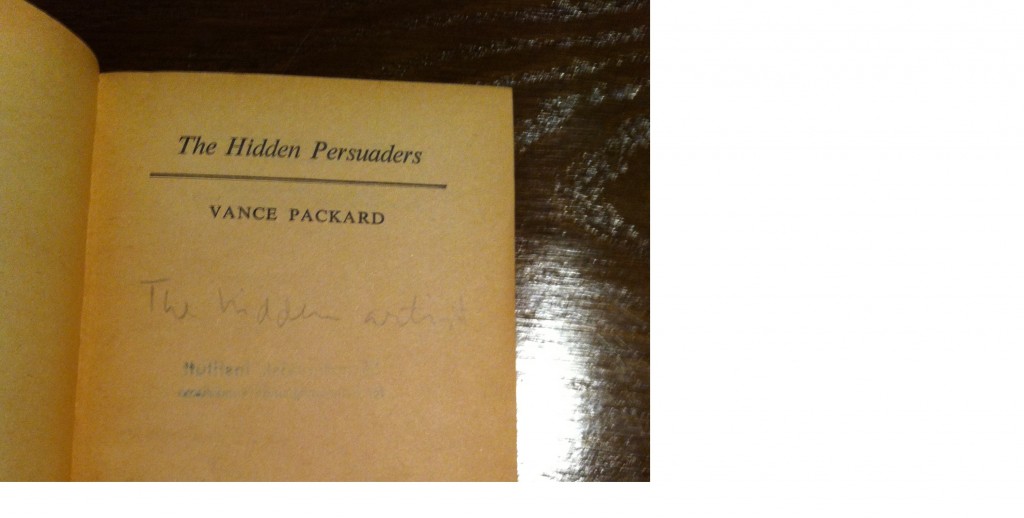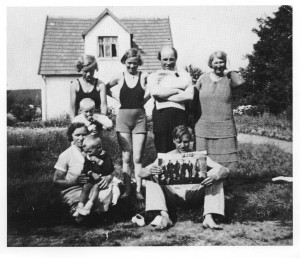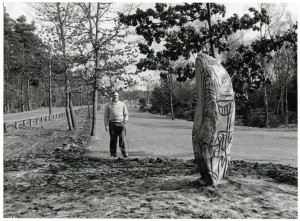AUTHENTIC IRONIES
The text below is an interview that was conducted with Karen Kurczynski in May 2015. Karen Kurczynski is Assistant Professor of Modern and Contemporary Art History at the University of Massachusetts, Amherst, USA and author of the recent publication The Art and Politics of Asger Jorn – The Avant-Garde Won’t Give Up, Ashgate, 2014. A slightly different version of this interview is published in the framework of the Art in Context Programme of the Rietveld Academy, Amsterdam in collaboration with the Cobra Museum for Modern Art. The theme for 2014/2015 was ‘laughter’.
HdB: The Danish experimental artist and thinker Asger Jorn (1914-1973) is well-known for being one of the co-founders of the postwar experimental artists’ group Cobra (1948-1951), and the Situationist International (SI), a movement of artists and intellectuals who strove to achieve social change (1957-1972). Many of those who study Jorn’s oil paintings, etchings, lithographies and other work, will find themselves smiling or even laughing about his puns and parodies, ironic or sometimes tongue-in-cheek humor. In your recent publication The Art and Politics of Asger Jorn: The Avant-Garde Won’t Give Up, Ashgate, 2014, the chapter ‘Authetic Ironies’ discusses the critical and expressive operations of Asger Jorn’s mature paintings, including parody. Here, you identify irony, parody and related strategies as a key element to understanding Jorn’s work, as “foundational to the social nature of Jorn’s aesthetic as a whole …”. Are you aware of previous art historical texts which attribute a similar value to Jorn’s ironizing (including self-ironizing)?
KK: This is an interesting aspect for me to consider now, as I work on an exhibition on Cobra for the NSU Art Museum in Florida (which will end at the Cobra Museum). Because Cobra was not interested in irony at all—or at least, that is what Christian Dotremont writes in one of his key texts, “Par la grande porte” (1949, in a catalog from Colette Allendy Gallery): “They are against ironic painting, which actually tries to express the organic joy of the universe, the historic joy of the world of 1949, but which is ashamed and which trims down the aesthetic impulse […] with an elegant little intellectual penknife.” Jorn too was more interested in authenticity in the Cobra years: he associated irony with the ruling class in his large c. 1947 manuscript “Blade af kunstens bog.” He then explored irony along with humorous strategies more and more over the course of the 1950s. In fact he was always interested in humor in art and in writing, co-authoring a parodic article on a Functionalist named “Everclean” in 1948. Already in his 1952 text Held og hasard, a very Nietzschean text, he rejects the idea of authentic expression. Then by the mid-50s, he openly espouses irony and “lying.” Historiographically, this is precisely the moment his art work begins to be celebrated on an international stage. The critics and curators like Werner Haftmann who wrote about it, however, emphasized it as a return to angst-filled expressionism. Contemporary critics especially in the US, where Jorn’s work is less well known, have continued to dismiss his work as expressionist (or worse, neo-expressionist—ironic and therefore empty) until very recently, after 2000. There are not many art-historical texts that place a high value on irony per se or self-ironizing in Jorn’s work until very recently, when suddenly that issue is becoming ubiquitous. I can’t think of any writer or curator who took his irony seriously until the 21st century, and now I can’t think of any who don’t take it seriously. Those who knew Jorn personally, like John Lefebre and Lawrence Alloway, certainly commented on his humor. It is really the writers you and I know now, our colleagues like Helle Brøns and Axel Heil, who are bringing this aspect into sharper focus today. It’s also related to the evolution of art historiography in general. Jorn (and Cobra) were not taken seriously because their work wasn’t perceived as “serious”—one of the most important key terms in postwar movements like Abstract Expressionism—so writers like Haftmann and Guy Atkins had to present his oeuvre as a serious engagement with major artistic themes. We are in a very different, much more interesting, moment now when artists contribute more writing on art and have helped influenced art critics and historians to recognize the importance of humor and play.
HdB: Irony and parody could be looked upon as a highly self-defensive modes, allowing someone to avert responsibility, to be indirect. However in the title of your chapter the words ‘ironies’ and ‘authentic’ are happily married. This seems to be a contradiction in terms but reading the chapter reveals that you locate the actual criticality and complexity of Jorn’s strategy in the dynamics between both elements. I would be curious to learn more about your perspective on the development of these dynamics. The ‘Authentic Ironies’ chapter discusses parody as a critical operation mostly in relation to work from the end of the 1950s into the 1960’s but (as you also mention) the concepts of irony and artifice are part of the development of Jorn’s aesthetic theory from the Cobra period (1948-1951) onwards. May I ask why you felt it was necessary to make this chronological distinction?
KK: The chronological distinction is really just part of the structure of the book, which focuses each chapter around a theoretical issue (in this case, expressionism and irony) combined with a particular temporal and artistic focus (in this case, Jorn’s mature painting ca. 1957-62). Jorn is interested in humor and play in art from the beginning, from his 30s Miró- and Klee-inspired works onward through Helhesten and Cobra. But I focused on different issues in my accounts of the earlier periods. Also, as I just mentioned, Jorn’s humor and irony come out much more explicitly in his late 50s and early 60s work than at any other period. Each chapter of my book has a title which is a deliberate contradiction, an oxy moron, in a Jornian spirit. It’s the clash of Jorn’s irony in a postwar age so obsessed with authenticity that gives his work such interest, and his position seems newly significant to us now as artists are returning to issues of abstraction and gestural painting but in an extremely sophisticated and sometimes overtly political way, combining abstraction and expressivity with some of the irony associated with pop art, appropriated imagery, and now digital mash-ups—when in the 50s and 60s those two approaches were strictly separated by generation. Recent artists are more interested in combining the best of both generations—the spontaneity and human element in the gesture, but without making it too specialized or spectacular; the humor and sophistication of using appropriated imagery but without it being too easy or celebratory. Jorn’s work does all of this. Today we have a much more sophisticated, “situational” understanding of identity and authenticity in the internet age, and new recognition of the importance of play in the era of video games and “gamification,” that I think makes Jorn’s work seem prescient and newly relevant.
HdB: The following question I have appropriated from a conversation with Jouke Kleerebezem, one of the tutors of the Rietveld Art in Context programme. He was wondering if we could touch upon the type of ambiguity that typifies humor in general, making the ‘laughter’ that results from it an acquired taste, always debatable between those who differ in their sense of humor. So then I wondered if you think Jorn shot himself in the foot every once in a while, and whether he perhaps did not care?
KK: Did Jorn shoot himself in the foot sometimes? Yes. Did he not care? No he did not care. His hits were so on target that I think they excuse a lot of misses that would stand out more in the work of an artist whose work was less complex and multifaceted. He always kept moving which is one of the fascinating things about his work and his artistic practice—it was also a source of heartbreak for those around him, from his wives and girlfriends to his kids, who suffered immensely, and his friends and gallerists. In terms of his humor, take a work like Masculine Resistance at the Museum Jorn, and you can see the retrograde gendered assumptions about the interaction of men and women that make its humor sort of fail from my own feminist perspective today (Helle Brøns has written about the gender confrontation in this work). But at the same time, the failure is itself interesting. It has something to tell us about mainstream gender attitudes in Jorn’s day, on the one hand, and it has a very critical message about the discourses of authenticity and transcendence that characterized art in his day, on the other. Its emphatic vulgarity in both how it was painted and the subject itself is a biting critique and a liberating rejection of the abstract painting that was dominant at the time. So it’s not humor as in a joke, which is always socially divisive (some of the best comics are the most offensive ones—Sarah Silverman for example). It’s more like meta-humor because the humor is always embedded in multiple and contradictory discourses. Jorn’s work is humorous in a way comparable to Richard Prince or Glenn Ligon’s “joke” paintings, which repaint a racist or sexist joke on a monochrome canvas, despite their radically different aesthetics. Whether you laugh at the joke is only part of the point—it makes you stand back and start thinking about what it means to laugh at it in different contexts, as well as (and this is key) the fact that the joke is always so culturally specific that it’s immediately outmoded and, well, no longer funny. So even Jorn at his most sexist or short-sighted has potentially important meanings for us. At the same time, just to negate everything I’ve just said (another Jornian move), I think you can also find passages of sheer physical humor in Jorn’s paintings that might be more universal—the way physical comedy appeals to a wider audience. You can also find references to carnivalesque themes and popular humor as seen in earlier painters like Bruegel and Bosch, and writers like Rabelais who Jorn loved. There are many different forms of humor present in Jorn’s work.
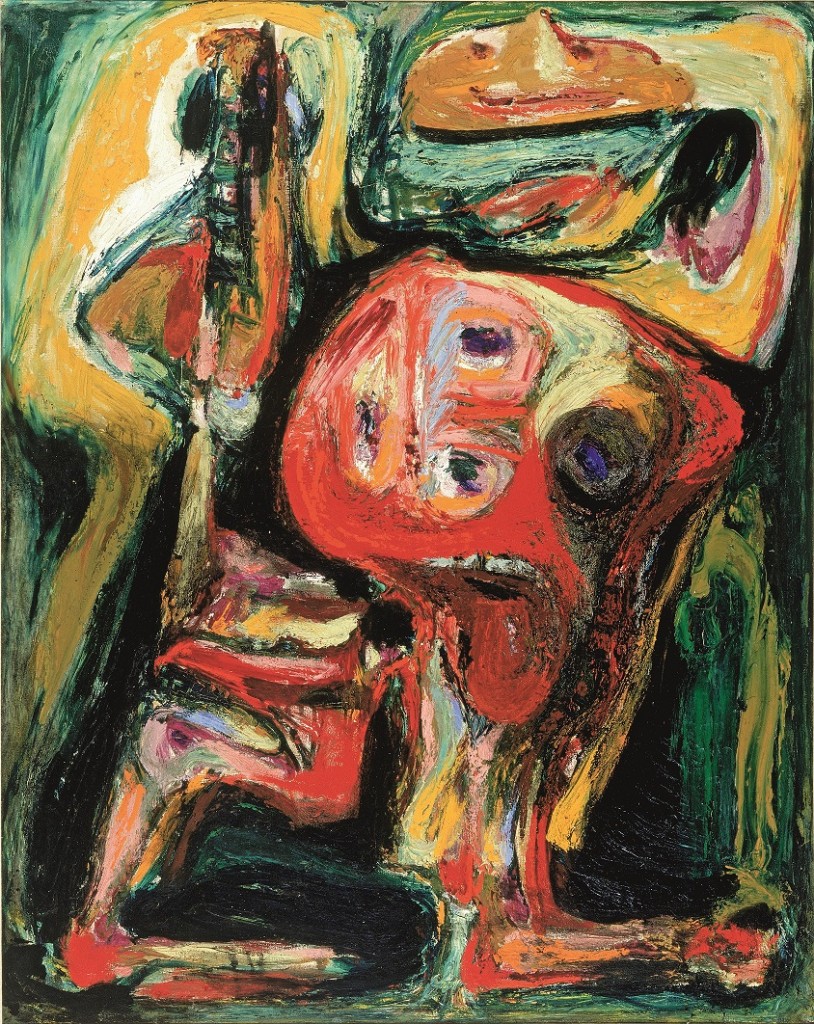
Asger Jorn, ‘Le faux rire (image tragi-comique)’, oil on canvas, 1954. Longterm loan by ABN-AMRO to the Cobra Museum of Modern Art, Amstelveen. Photograph: Henni van Beek
HdB: In 1954 Jorn made an oil painting that literally depicts laughter: Le faux rire (image tragi-comique) which translates as The Fake Laughter (tragic-comic image). At the bottom of the painting we see a (literally) two-faced laughing character in a slightly awkard, half-reclining position while holding something up in the air with one arm. In the background above the laughing character hovers a smaller, friendly looking face. Although the painting is the representation of a fake emotion it funnily enough simulaneously brings across a genuine emotion, the mix of twisted feelings that potentially come with a fake laugh (discomfort? repulsion?). I would like to invite you to closer examine this painting from the perspective of ‘authentic ironies’. In relation to Jorn’s paintings La double Face (The Double Face) and Le Cri (The Scream) you for instance bring up notions such as multiplicity, clichés of the representation of human emotion, the understanding of complexity of the self as a social situation, and Jorn’s insistence on meaning-production as an active process.
KK: This is a great work to bring into focus the complexity and multiple dimensions of laughter we just touched on. The image strikes me as very grotesque in its combination of comic and tragic—humor and angst—in a particularly puzzling combination. The history of the grotesque from ancient times (when it was called the “monstrous”) to the present, as many scholars have demonstrated, typically combines humor with horror. So it relates to a prominent theme in human culture. We can all think of examples of situations that are horrible or harmful that, when considered at a remove, can also be really funny (though at the time it was still largely taboo in Europe to produce humorous imagery relating to the Second World War—Jorn’s work plays with those taboos only indirectly). This image features not just those two dimensions of tragedy and comedy, but also a third, the question of “fake” laughter. The issue of something fake destroys any notion of authenticity and cuts through any attempt to securely define something. Then, Jorn began his painting Stalingrad, le non-lieu, ou le fou rire du courage, the same year—the first title of that painting was “Le fou rire” (Mad Laughter) and it may or may not have been a reference to history or history painting or the “mad laughter of courage” in an epic battle at that point. It acquired the title Stalingrad a bit later. Jorn loved puns and I think it’s likely that he linked le fou rire and le faux rire together deliberately. Fou being a reference to an authentic expression; faux indicating irony and inauthenticity. What strikes me about this image is that it seems more troubling than funny, so is it about laughter at all? Or really, it’s precisely about laughter rather than explicitly funny. It is about the significance of laughter. Laughter and play are elements that rational society suppresses and they indicate a critical distance, a resistance to power. They are also intimately linked to creativity itself and the ideas of play and experiment so prominent in Cobra. Laughter indicates a double perspective. The main figure is not just laughing, but sticking out his tongue, which is a gesture of childishness, defiance, as well as disgust; a gesture referenced earlier in Cobra and examined in Jorn’s later book La langue verte et la cuite. The material fleshiness of the painting is also striking. Parts of figures evoke blood and bones, the mouth and the tongue, the eyes made grotesque as they multiply and roll in all directions. It’s an image of illness (recalling Jorn’s abstract portrait of his injured cousin Mads in the Silent Myth murals) and madness, so strongly linked to creativity. It’s also a visceral painting that affects us in an almost physiological way. As it was made in Italy, this was part of Jorn’s reaction against the sleekness of postwar design culture and his investigation of ceramics at the time. It’s a great example of his interest in Bachelardian ideas of the “material imagination.” It is grotesque because it fails to cohere as a recognizable group of figures. Instead it conveys the process of signification. Maybe it even conveys the process of creating humor itself, and its flipside, tragedy itself, out of the neutral facts of what happens in the world. There is also a recognition implicit here (but signified by the contradictions inherent in the title) that the process of signification is always social. So what one calls greatness, another calls tragedy, and yet another calls humor.
GO TO HELL BASTARD – Asger Jorn’s construction of his public image
A slightly different version of this text was published in ‘Public Relations’, Rietveld Academy, Art in Context Programme. Amsterdam, May 2014. Eds. Sasa Karalic and Jouke Kleerebezem.
Those who study Jorn get to know him as an energetic and charismatic personality, always on the move and looking for exchange and discussions with others through meetings, the making of collaborative work or magazines, or exhibitions. These discussions were regularly held in public or semi-public realm of conferences and newspapers. Jorn’s output as an artist coincides with a considerable amount of anecdotes and photographs that confirm the impression of him as a playful, spontaneous, and also (thought)provoking and going-against-the-grain type of free spirit that is hard to label or pin down.
When asked to contribute a text to the Art in Context (2014) publication of the Rietveld Academy around the topic of PR, I immediately had to think of how these anecdotes have become inextricably bound to his reception as an artist. It is hard to discuss Jorn and leave these anecdotes out, whereas at the same time there are aspects of Jorn that have been largely ignored in art history, such as the sometimes misogynist tendencies in his writings. As it turned out that Helle Brøns’ PhD research on Asger Jorn includes both a critical questioning of how Jorn himself actively contributed to his public image and gender issues I decided to interview her. Helle Brøns is an art historian who lives and works in Copenhagen working on a PhD on Asger Jorn at the University of Copenhagen, the Statens Museum for Kunst, and Museum Jorn. She is the author of Asger Jorn, Copenhagen 2009; “Masculine Resistance. Expressions and Experiences of Gender in the Work of Asger Jorn”, in October: Asger Jorn: A Special Issue no. 141, 2012 and “The Shock of the Old”, in Hvad Skovsøen gemte. Jorn’s Modifications & Kirkeby’s Overpaintings, Museum Jorn, Silkeborg 2011.
The notion of self-promotion, and the ways that artists actively influence the reception of their work, is a relevant one also in the present time. It is a time in which artists and intellectuals are required to possess of quite a few ‘entrepreneurial’ skills, including networking and self-promotion skills, and dealing with the press. This current call for cultural entrepreneurship has been criticized by sociologist Pascal Gielen as “a misunderstanding”. (Pascal Gielen, ‘Repressive Liberalism – Art, the Art Market and the Cultural Policy System in the Netherlands’ in Kunstlicht 1/2 (34), ‘De Publieke Markt’, 2013) A free translation of his words: “it is in fact a call for self-management, for calculability (yet how can one ‘measure’ the time that is needed to come up with a new idea?) and controllability – the risks of shaping new ideas and objects has to be within acceptable proportions of risk.” Gielen’s critique might be justified, but the ‘entrepreneurial’ aspects of artist hood are an issue usually not ignored by artists that carried to ambition to put a mark on the art and discourse of their time. Asger Jorn definitely belongs to this category of artists.
***
HdB: Risk was an important element in Jorn’s thinking and strategies and certainly not something that he would be willing to shrink to ‘acceptable proportions’ in the ‘entrepreneurial’ sense. I would rather agree with you Helle, that Jorn was “unrelentlessly reckless”. He compared artistic practice with walking on thin ice, and I think that it is in line with this, that he disliked it if people would get a too clear picture of him. He would then undermine that picture, withdraw or do something unexpected so that it was difficult to type cast him as an artist. This does however not mean, that he didn’t like to be acknowledged or recognized as an artist. Chronologically speaking, the very first thing that springs to mind, is the fact that Asger Jorn was born Asger Oluf Jørgensen. He changed his name in 1945, the year that the borders of various European countries opened up again after years of war. In the literature about Jorn his name change is generally interpreted as a way to make it easier for an international network of people to remember him. Would you like to add to that interpretation, and, secondly, do you happen to know if Jorn has ever publicly motivated his name change?
HB: I think the change of name was mostly a question of practicality. Jorn wrote to the Danish artist Robert Jacobsen “Robert, we must have different names. It doesn’t work at all to arrive in France and be called Jørgensen and Jacobsen. Nobody can pronounce it. Damn it, I’m going to find myself another name.” I don’t know of any public motivation, so there is probably no more to it than that. What this does tells us, however, is something about Jorn’s self-confidence. That right after the war he was determined to go out and make himself an international career and that he was very conscious of the importance of having a name in the public. But “Jorn” really isn’t the easiest name to pronounce either, is it? ….. In his local Danish dialect “Jorn” can sound like “Jorden” (the earth) which he might have thought of as a funny connotation. (In Århus in the 1980s someone wanted to name a café after Jorn and were not allowed – they then called it Cafe Jorden as a prank.)
HdB: During the preparatory talk for this interview, we briefly mentioned two photographs of Jorn that we both found striking in the context of the issue of self-presentation and dealing with the relationship with the press. One is a photograph published in the catalogue Expo Jorn – Art is a Festival!, by the Museum Jorn in Silkeborg in 2014. It is a black and white photograph of Jorn, some youngsters and two adults walking up a hill. They are all playing musical instruments. The other example actually concerns a series of photographs of Jorn and art collector Elna Fonnesbech-Sandberg taken for Billedbladet in October 1944. What do you feel is most striking about these photographs?
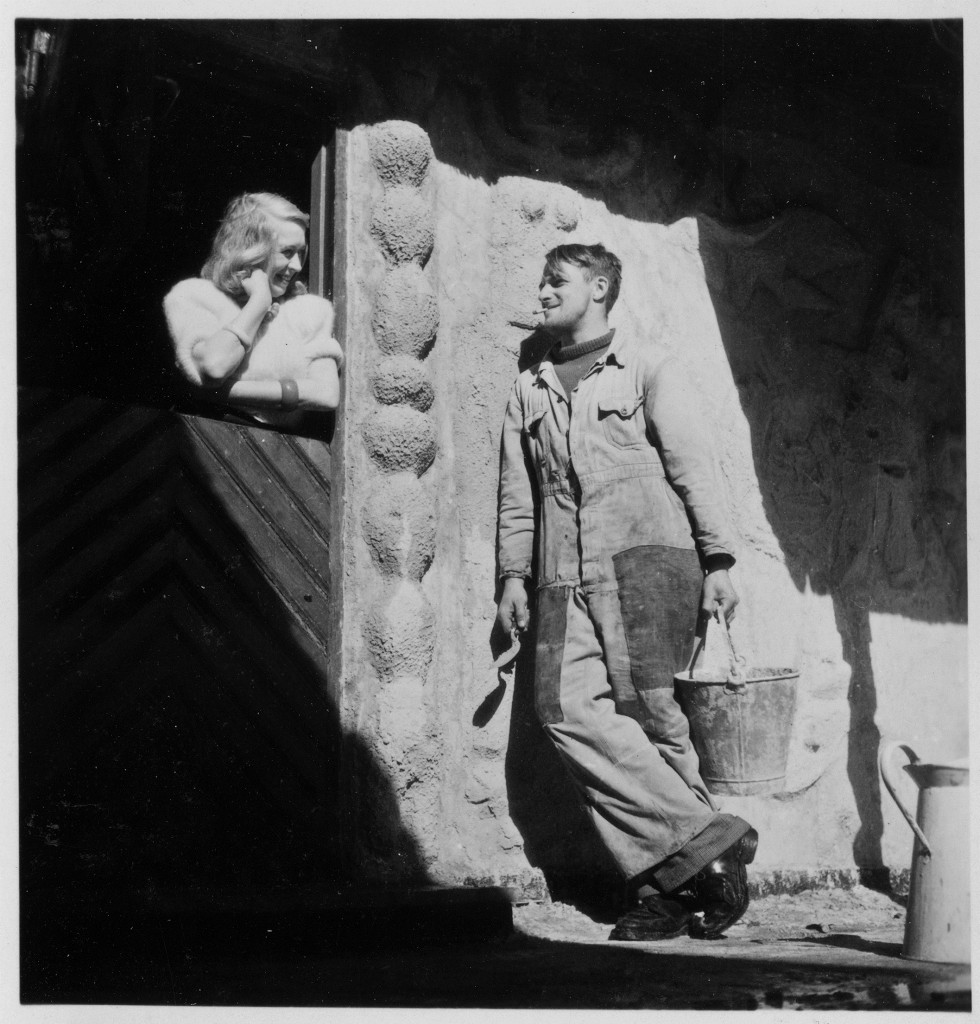
Asger Jorn and Elna Fonnesbech-Sandberg at her Summer house, October 1944. Photography by Olaf Kjelstup for the magazine 'Billedbladet'.
HB: The photographs from Billedbladet are interesting both because they reflect the perception of the artist’s role at the time, and because Jorn so willingly plays the part of the young, bohemian, masculine artist. He is in a boiler suit working outdoors or taking a break while Elna Fonnesbech-Sandberg looks at him in appreciation from inside the house – she is passive, approving and always photographed indoors. The setting is sufficiently domestic and normalized for people to identify with the artist and thereby more easily accept his ‘strange’ modern art. It is a classical setup – which we also know from the photographs of Jackson Pollock and Lee Krasner. Krasner, though being a splendid artist herself, is portrayed as the supportive, admiring wife, while Pollock is performing his drips – which served to anchor the Pollock’s art work in the figure of a white, male (heterosexual) artist. In Jorn’s case however, the woman was not his wife, but his mistress and patron (and future painter and artist colleague). So the rather conventional photographs that seem confirmative of the bourgeois norms and morality in reality covers an even more complex reality. Even if Jorn posed in the public media as a typical artist hero, at the same time he was very critical towards this notion of the genius artist individual, and warned that an artist who lets himself become a celebrated hero will stand in the way of his own art as popular or folk art – which is what he wanted his art to be.
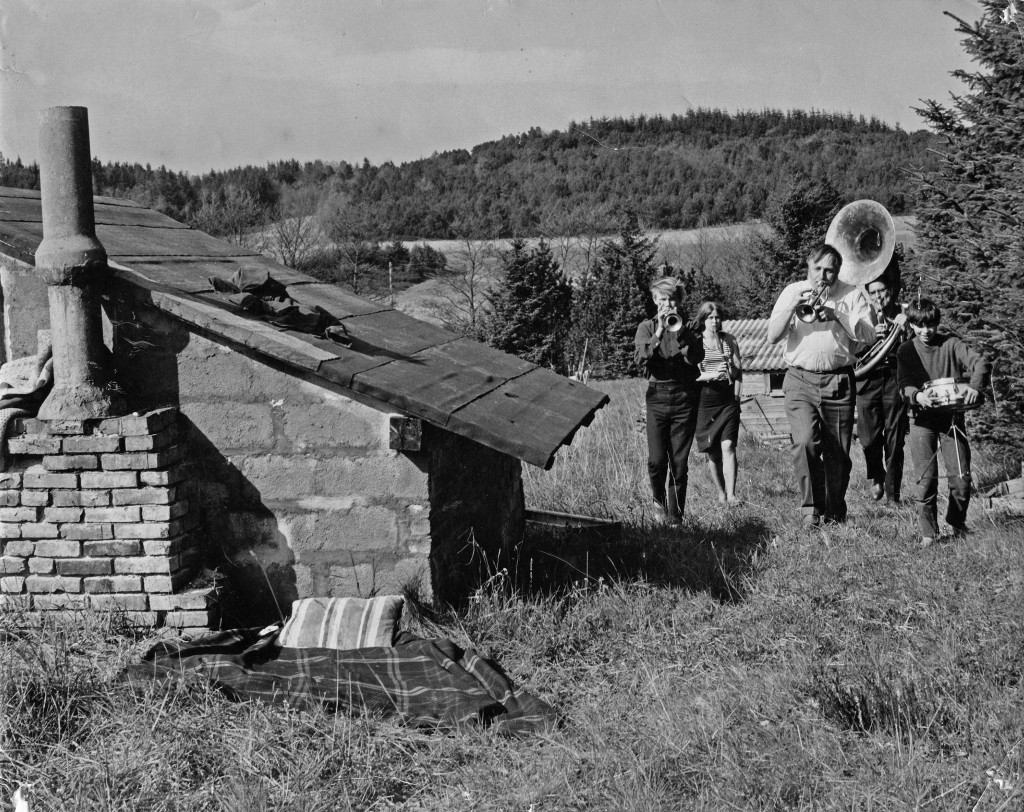
Asger Jorn, Erik Nyholm, Verner Permild and others in a music procession at Erik Nyholm’s place. Photographer and date unknown.
The photo with the music procession was taken at Erik Nyholm’s place (he was a ceramist and a friend of Jorn). He and Verner Permild (a printer) are the other two men the photo. It looks like a happy, spontaneous moment luckily captured on film and it might well have been so. But very often Jorn also initiated such “happenings”, when a camera appeared. He was very good at using such moments to pose as a “bohemian” artist. His son told me that he sometimes put an instrument in everyone’s hands when someone took photographs. When the son objected that he didn’t know how to play it, Jorn said that it didn’t matter – you couldn’t tell from the picture. Again, it shows how conscious Jorn was of how to present himself as a lively, impulsive artist living up to the public expectation, while in reality he was also very strategic and theoretical. I think it might be part of the reason why his theoretical work was not acknowledged as part of his “real” oeuvre for many years.
HdB: The photographs we just discussed show Jorn to be quite strategic with the media, but you told me about a conversation you had with one of Jorn’s children. Apparently Jorn once said that “now he was as good as Picasso was in dealing with journalists”, right after he had answered a journalist from an important newspaper at his front door (who obviously didn’t know what Jorn looked like) that Mr. Asger Jorn wasn’t home, and closed the door. Whereas it is not my intention to try and speculate too much about his motivations for his action (which would suggest that a clear picture could emerge), it seems to me that generally speaking the anecdotes around Jorn generate from more or less spontaneous responses, but that he also knew very well how to use these anecdotes to his advantage or to create a certain image of himself – or if necessary distort that image again. How do you think of Jorn’s ‘strategy’ to always add to complexity and readability of his personality as an artist, his artistic work, in relation to our current times, and to an audience that is already overloaded with information?
HB: I cannot help thinking of the way the British art critic Tom Wolfe in his satirical 1975 book The Painted Word describes the play between the artist and the cultural elite as the “Boho Dance”. An artist can only be successful, he argues, if he knows the rules of this dance: first the bohemian artists performs his moves of utter disdain for the bourgeoisie, at some point the cultural elite will nevertheless make a move towards him and after some discreet hesitation he must accept the accolades and attention.
Wolfe argues that if the artist gets stuck in a crippling disdain for his audience and cannot accept the offer to dance when it is made, he is doomed to stagnation and will not be revered by history. Artists like Picasso excelled at this art mating ritual, he said, while Pollock was the classic case of the artist hopelessly stuck between the Boho Dance and the fulfillment. A few artists however managed to double-track their way from the Boho Dance to the consummation, but truly successful double-tracking requires the artist to be a sincere and committed performer in both roles, he argues. I think this is what Jorn attempts – to be true to his communist belief and at the same time have success without kissing ass. As is typical for him, he tries to change the rules of the dance. Wolfe points out that the general public was not part of this transaction; perhaps one could say that Jorn attempts to move the dance into their territory (by connecting so strongly with folk art and popular art). Particularly in his Situationist period of course he was split between the success of his painting and the anti-capitalist critique of the SI – this split made him invent an alter ego – George Keller – who stayed in the SI while Jorn resigned. He then canalized some of the money earned on painting back into the subversive activities in SI.
I think the Boho-dance is still in function today – think of someone like Damien Hirst – but of course the scene has changed radically. The performance, which was for a very long time acted out on a unisexual scene – was overplayed and can no longer be presented as natural or credible. There are more artist roles available and a much broader cast. Also, many artists today work with the public media as a medium – a strategy that the situationists were some of the first to use – but the attitude of most younger artists towards media, institutions or consumer society is much more workable and diverse. The recognition of artistic research that Jorn struggled for is very relevant today and in some ways obtained, which also allows for different relationships between artist and public.
HdB: During his lifetime Jorn wrote a great deal of texts. He was very outspoken about many topics, and he was a well-read man. in the reception of his texts at the time, and still today, his textual and more philosophical output are primarily considered an example of artistic thinking. In the 1950s however, Jorn send in one of his existing manuscripts at the University of Copenhagen, asking to consider it as a dissertation. The university rejected his application, which as you suggested, could not have come as a big surprise to him. Do you think that he really wanted to position himself as an intellectual, or what else do you think might have been his agenda with this application?
HB: Yes, in 1952, he submitted his aesthetic manifesto Luck and Chance to the University of Copenhagen in order to have it accepted as a philosophical doctoral thesis. The book was rejected because it did not meet the university’s academic requirements, full as it was of intuitive leaps and argument from one discipline used in the field of another. I believe his purpose was to proclaim the existence and value of an artistic way of thinking as an equivalent alternative to the philosophical and scientific one. His theoretical work was both very sincere and at the same time it included a humorous, irrational aspect which was not compatible with academia). Jorn strikes me as an intellectual who does not want to be intellectual. In his introduction to a later book The Natural Order, he stated that success as a philosopher would be “the most embarrassing and ridiculous thing I could ever achieve. It would be like giving a man who loves women the most beautiful wax mannequin in the world, complete with real hair.” What he cared about was the “real thing”, a living, passionate sensuous reflection rather than an elaborate, but lifeless, philosophical thinking. In the same book he claims that “We need a Ministry of Disturbance, a regulated source of annoyance, a destroyer of routine, an underminer of complacency, or, in other words, a ministry of aesthetic activity.” I think Luck and Chance was intended as such a disturbance.
HdB: Jorn was quite critical of the idea of the museum as the arbiter of taste and what could be called the culture industry of his time. When Jorn was awarded the Guggenheim Award in 1964, he send a telegram to the president of the Guggenheim saying:
GO TO HELL BASTARD—STOP—REFUSE PRIZE—STOP—NEVER ASKED FOR IT—STOP—AGAINST ALL DECENCY MIX ARTIST AGAINST HIS WILL IN YOUR PUBLICITY—STOP—I WANT PUBLIC CONFIRMATION NOT TO HAVE PARTICIPATED IN YOUR RIDICULOUS GAME.
On January 8, 1964 he also send a longer letter explaining himself in more detail, stating that he has always refused any price as “pricegiving is the establishment of an hierarchic distinction between artists”, and on top of that he adds that refuses to be used as “an example to artistic and public education, as I hate every sort of education en bloc.” The Danish writer and critic Elsa Gress (1919-1988) however, didn’t necessarily think of Jorn’s action as daring or risk-taking, but pointed out that he might gain more from all the media attention then from the award itself. Could say a little more about what she said, and in what context their subsequent dialogue took place?
HB: I think the rejection of the Guggenheim Price is a perfect example of Jorn’s attempt at double-tracking: a perfect abusive Boho dance move but at the same time he got more publicity without compromising his convictions. What Elsa Gress did was in a way to expose this transaction as part of the game. She discussed how abstract spontaneous art had become academic and that there was too much speculation and publicity in art – even Jorn who just turned down the Guggenheim price uses publicity, she says. Jorn wrote an angry reply, refusing to ever have used publicity besides the publicity implicit in every artistic statement. Gress then pointed out that because of his constant presence in the media, his writing, debating and self-conscious appearance Jorn’s public persona, whether he wanted it to or not, confirmed the image of the artist as a genius bursting with masculine vitality and agency. This artist’s role expressed the last gasp of patriarchy, as she saw it, noting Pollock as an example of a male artist self-destructively living his own myth. This was a sore spot for Jorn, who himself saw modern society as being increasingly influenced by what he defined as female values of harmony and stagnation, while masculine values such as experimentation, aggression and innovation lost territory. In the following discussion they both projected gender differences onto their arguments.
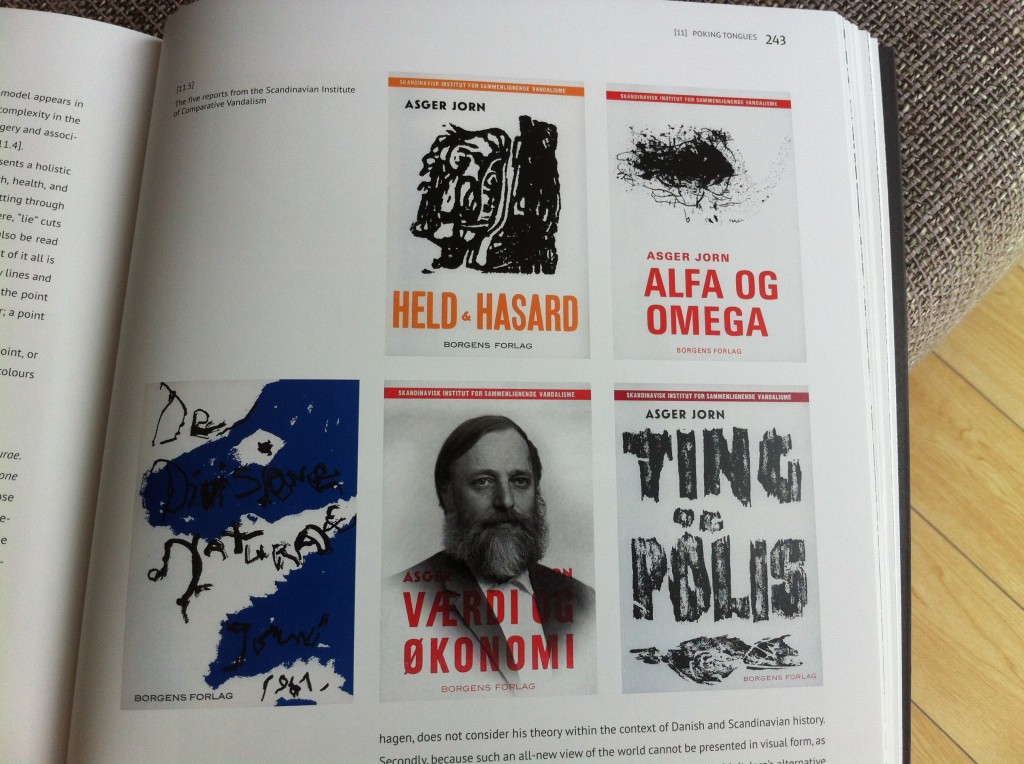
Photograph of a page from 'Asger Jorn - Restless Rebel', Statens Museum for Kunst, Copenhagen 2014. The page includes book covers of books written by Jorn, including 'Value and Economy' which shows Jorn posing as Marx.
Gress – taking off from Simone de Beauvoir, Margaret Mead, and others – was advocating for a general humanism that does not discriminate between the sexes, while Jorn stressed the generic differences between the sexes. In his book Alpha and Omega he continues this discussion of art and gender in rather misogynist terms. He does, however, also have a very humorous and ironic tone, which is also evident in his art – not least the modifications and disfiguration which ridicule both men and women. Such “self-portraits” as the one at the cover of Value and Economy, where he poses as Marx is a similar ironic self-representation: He puts himself as an artist thinker in the place of the philosophical father figure. In another photograph he poses as the little mermaid and ironically shows himself as a paradoxical, popular national symbol with breasts, pipe and beard. I think it is a great picture of his self-ironic attitude to his public image as a masculine artist hero.
The Hidden Persuaders / The Hidden Artist
I would like to conclude this interview with thanking Helle Brøns for her time, energy and insights, and with a photograph that I took at Museum Jorn, in a small room that contains part of Jorn’s personal library. It is a photograph of the title page of the book The Hidden Persuaders by Vance Packard, underneath which Jorn wrote ‘The hidden artist’. It is an interesting note perhaps to end with, as Jorn draws a direct parallel between the artist’s practice and the work of PR managers and other ‘persuaders’.
Packard’s book The Hidden Persuaders was first published in 1957, and according to his underlining of many paragraphs, Jorn must have read it with interest. Packard looks into the use of psychological techniques by advertisers to influence the behavior of potential buyers. Packard identified several “compelling needs” that advertisers promise products will fulfill that according to him are so strong that people are not able to resist the impulse to buy. Packard also looks into the manipulative techniques of promoting politicians to the electorate and questions the morality of using these techniques.
In ‘The Exploitation of the Unique’, the second part of his publication Value and Economy, Jorn discusses the subjective and human passion at length in relation to art, politics and advertisement. He writes for instance: “The best object for exploitation in human society is human desire and enthusiasm and the creative results of this, our cultural past” and “Politics consists of catching people’s attention and is thus art.” (Asger Jorn, “Value and Economy – Critique of Political Economy and The Exploitation of the Unique’ in The Natural Order and other texts, translated by Peter Shield, Ashgate 2002) At the core of his thinking lies the idea that art is the ultimate tool for invoking differences in values, for invoking change and that only changes can catch people’s attention. He then indeed draws a parallel between art and advertisement saying “(…) academics have made a false separation between what they call art and what they call advertisement. They simply refuse to admit the obvious that all art, even that of Beethoven and Rembrandt, is art because, amongst other things, it is an advertisement for something, and that to advertise is to give sensory experience an extraordinary significance. That a sensory experience is given an extraordinary significance is first and foremost to say that that one is conscious of it as something important and something present.” (Value and Economy)
In ‘Value and Economy’ Jorn shows himself critical of the role of mass media in the dependence of politicians’ popularity and he shows himself critical of the role of the advertisement industry in relation to commodity consumption, but perhaps most importantly in the framework of the artistic practice, he shows himself critical of academic thinking about the value of sensory experiences. He says that the consciousness, the focus of attention that artists can generate “is what in the most elementary sense could be called intelligence”.(Value and Economy) Academics, according to Jorn, have refused to acknowledge the intellectual aspect in this process. To Jorn however, intelligence does occupy itself with experiences of reality, not only with concepts. He can’t relate at all to the academic concept of reality as something that cannot be experienced but only comprehended: “Art is to be able, but to be able is also to know” (Value and Economy) says Jorn, which to him means that you can’t remove knowledge from art, or isolate direct knowledge from the problem of intelligence.
It is useful to realize how aware Jorn himself was of the importance of human desire and the focus of attention where it comes to his public image. The image of Jorn as a bohemian artist did not occur as ‘naturally’ or spontaneously as it looks like at first glance, and a critical look at his practice and thinking from the perspective of gender issues also completes our image of him in a different way. At the same time, the numerous photographs of Jorn smoking, of Jorn working with paint, clay or textile, of Jorn eating, drinking, of Jorn flirting, of Jorn playing a musical instrument, but rarely of Jorn not engaging with the world of matter around him, seem to focus our attention not only to him but also to one of the most fundamental ideas underlying his practice, which is that through experimenting, a direct engaging with matter, art invokes differences, and by invoking differences art generates knowledge about ourselves and the world around us. This is not the ‘scientific’ or objective type of knowledge, but a type of knowledge that issues from the subjective, from the needs of mankind. In terms of art, to Jorn this was the true meaning of realism – which when you come to think of it, sheds another light of some of the photographs discussed above. Perhaps Jorn’s ‘manipulations’ were foremost aimed to bring across the image of something as ‘real’ as possible.
JORN AS A COMMUNIST
This is a brief report on Morten Thing’s contribution to the ‘Cut and Thrust: Reconsidering Asger Jorn’ seminar workshop which took place at the Museum Jorn in March 2012. Below, you will also find his answer to my question about Jorn’s continued membership of the Communist Party.
Morten Thing, writer and research librarian at the in Cultural History at RoskildeUniversity, gave a thorough, chronological overview on Jorn as a communist. He described Jorn starting out as a passionate romantic member of the Communist Party who was however from the beginning strongly opposed to art becoming a political tool in itself, and to style doctrines. Jorn’s unorthodox approach (which he was infused with at an early age by his mentor/father figure Christian Christensen) lead him to formulate such essential critique on Marxian economics that Jorn himself believed it would have led to dismemberment of the Communist Party, had they ever actually read his critiques. Jorn stayed a member of the party until his death though.
On a personal note: What I had secretly been hoping for, is that Thing’s presentation would also include Jorn’s theory of what he called triolectics. This didn’t happen, but I have to admit that it would probably have required Thing´s talk to last at least thirty minutes longer …. Anyway, triolectics, this “thinking device” as Peter Shield calls it, merges Niels Bohr’s theory of complementarity and Marxian dialectical materialism. One of the attendees of the seminar stated that once I would be able to fully comprehend this, I would basically have a grip on the essence of Jorn’s thinking. I can’t unfortunately claim that I am there yet! Morten Thing did bring up something that keeps coming back to me though, an article by Jorn which only appeared in Danish I believe but which in English would translate into ‘Everclean a rational human’. The article supposedly is a semi-fictional story of the life of a functionalist man called Everclean, and was an attack on Poul Henningsen, party leader and a functionalist architect. Sounds like it would be fun to read.
Question to Morten Thing: You described Jorn as a passionate romantic member of the Communist Party, in the first years of his membership. In the light of Jorn’s later critiques on Marxian economics, and in contrast to that, his continued membership of the Communist Party, would you say he never ceased to be romantic?
Answer: To be a ‘romantic’ communist it means at least in words to be a ‘stalinist’. Jorn’s early texts leaves no doubt, that he seriously tries to write in the communist lingo. What is most severe to the place of art in his understanding is, that there is a direct link from one’s political views to one’s art. Therefore Diego Rivera is seen as a traitor to art and communism because he is a friend of Trotsky. This doctrine or close circuit, he changes during the war, seeing that the relation between art and politics and society in all is much more complicated. In his texts from the years shortly after the war, he still in words try offensively to defend the CP, but leaving the art/society question out. I see this as a sign of the development of a revolutionary thinker struggling with the understanding of art and the CP-discourse. Although he defies the CP understanding, he never leaves the party, but he knows that his views are not those of the CP. In that way he is a romantic revolutionary and I see this as a strong link back to Christian Christensen, the source of his collectivist and revolutionary thinking.
